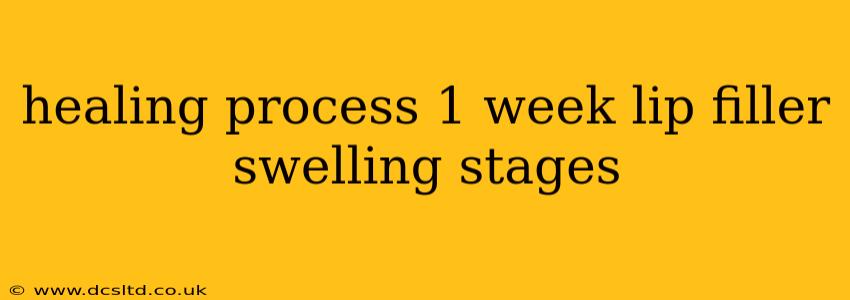Lip fillers are a popular cosmetic procedure offering a boost of volume and definition. However, swelling is a normal part of the healing process, and understanding the stages can ease anxieties. This guide details the typical swelling stages during the first week after lip filler injections, answering common questions about recovery.
What are the typical stages of lip filler swelling in the first week?
The swelling after lip filler injections varies from person to person, depending on factors such as the amount of filler used, the injection technique, and individual healing responses. However, a general timeline for the first week includes the following stages:
-
Day 1-2 (Immediate Swelling): Expect significant swelling immediately following the procedure. Your lips may feel quite full, even tense, and potentially slightly bruised. This is the most intense swelling phase. Ice packs applied regularly during this period can help minimize it.
-
Day 3-4 (Peak Swelling): Swelling often peaks around day 3 or 4. The fullness might appear more pronounced than on day 1 or 2, depending on your body's reaction. Don't panic; this is a normal part of the healing process. Continued icing and gentle elevation of your head while sleeping can aid in reducing swelling.
-
Day 5-7 (Gradual Reduction): From day 5 onward, the swelling usually starts to subside gradually. You'll likely notice a visible reduction in puffiness each day. While still noticeable, the swelling becomes less dramatic.
How long does it take for lip filler swelling to completely go down?
While significant swelling reduces within the first week, complete resolution can take several weeks, sometimes even a month or more. Individual variation is key here; some people experience faster healing than others. Patience is crucial. The final results, free from swelling, are usually apparent after a few weeks to a month.
What can I do to reduce lip filler swelling?
Several strategies can help manage swelling and discomfort:
-
Ice Packs: Applying ice packs for 15-20 minutes at a time, several times a day, during the initial days is highly recommended. This constricts blood vessels, reducing swelling.
-
Elevation: Keep your head elevated while sleeping to minimize fluid buildup in the lips.
-
Avoid Alcohol and Smoking: Alcohol and smoking can impede the healing process and increase swelling. Refrain from both for at least 24-48 hours after the procedure.
-
Gentle Cleansing: Cleanse your lips gently with a mild cleanser to prevent infection. Avoid harsh scrubbing or rubbing.
-
Arnica: Some people find arnica supplements or topical creams helpful in reducing bruising and inflammation, but consult your injector before use.
-
Follow Your Injector's Instructions: Adherence to your injector's post-procedure instructions is vital for optimal healing and minimizing complications.
Is it normal to have lumps or bumps after lip filler?
Minor lumps or bumps might be present initially, often settling down as the swelling reduces. However, significant lumps or persistent irregularities might indicate a problem, requiring consultation with your injector. They can assess the situation and offer necessary adjustments.
What should I do if I'm concerned about the swelling?
If you experience excessive swelling, severe pain, or other unusual symptoms, contact your injector immediately. They can evaluate the situation and provide appropriate advice or treatment. Don't hesitate to seek their professional opinion if you have any concerns. Early intervention is key to addressing potential complications.
Disclaimer: This information is for educational purposes only and does not constitute medical advice. Always consult a qualified and experienced medical professional for any health concerns or before undergoing any cosmetic procedure. The information provided here is based on general observations and individual results may vary.
